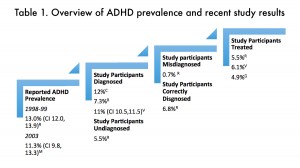HOW CAN WE HELP YOU? Call 1-800-TRY-CHOP
In This Section
The Rising Tide of ADHD Rates: Is There Evidence for a Flood of Cases?
By James Guevara, MD, MPH, and Maritza Pedlar, MPH
A recent news report suggests that attention deficit-hyperactivity disorder (ADHD) rates among children have risen dramatically over the past decade. The report cites information from a recently published paper in the Journal of Clinical Psychiatry that analyzed data from the National Survey of Children’s Health, a survey of nearly 200,000 parents of children and adolescents from across the country. In that paper, the authors found that rates of parent-reported diagnoses of ADHD had risen 43 percent from 8.4 percent in 2003 to 12 percent in 2011.
To understand whether ADHD rates have truly risen or not, one needs to assess the different methods that researchers employ to identify rates of ADHD and other behavioral health diagnoses. In one method, researchers screen all children for ADHD at schools and then conduct detailed interviews with parents of those children who turn up positive on the screens. This allows researchers to identify the overall rate of children who have ADHD regardless of whether or not they have ever been diagnosed or treated for it. However, this method is expensive and time-consuming, and it is only feasible in small well-defined geographic areas.
In another method, researchers can survey parents whether their children have ever received a diagnosis of ADHD and whether they received treatment for it. This permits researchers to identify the rates of diagnosed and treated children with ADHD. This method is fairly simple, but it can lead to errors if parents remember diagnoses and treatments incorrectly. In addition, this method does not allow researchers to identify children with undiagnosed ADHD.
Another approach to identify rates of diagnosed and treated ADHD is to analyze large administrative files such as insurance claims files. This method employs diagnostic and medication codes in the databases to identify children with ADHD but can underestimate rates if children do not seek treatment for ADHD or lack access to appropriate healthcare services.
So what do recently published studies that employ these research methods find regarding rates of ADHD?
In a study conducted in a rural county in North Carolina in 1998-1999, researchers screened nearly 8,000 children in 17 public elementary schools for ADHD. Teachers screened 80 percent of children using a behavioral rating scale, and parents completed detailed interviews with researchers. The researchers estimated that 15.5 percent of children at those schools had ADHD, but only 58 percent had ever been diagnosed, and only 42 percent were taking medication to treat ADHD.
Using a similar method, another group of researchers screened over 17,000 children in public elementary schools in South Carolina and Oklahoma in 2005 and estimated that 8.9 percent to 29.8 percent of students had ADHD depending on the exact classification scheme employed. However, using a scheme that most closely approximated the previous study, the researchers found an overall rate of 11.3 percent.
When researchers employed survey methodology, they reported somewhat lower rates of diagnosed ADHD than the overall rates reported using community screening above. For example, one group of researchers analyzed the National Survey of Children’s Health, but chose a different age cutoff than the first study mentioned above and found a similar rate of 11 percent of children who had a parent-reported ADHD diagnosis in 2011.
A group of researchers who examined administrative claims files reported even lower rates of treated ADHD. They analyzed medical records from the Kaiser Permanente Southern California Health Plan and found an overall rate of 4.9 percent of children age 5 to 11 years old who had a diagnosis of ADHD.
What can we conclude from these various studies on ADHD rates in children?

Table 1. Summarizes the results of the following studies: C (Collins & Cleary, 2015); R (Rowland et al., 2013); V (Visser et al., 2014); M (McKeown et al., 2015); G (Getahun et al., 2013)
As seen in Table 1 (click to enlarge), it would appear that the overall rate of ADHD, including both diagnosed and undiagnosed ADHD, is high and unchanging. Community screening procedures conducted at different time points in the past 17 years report rates of 11 percent to 16 percent, with rates varying as a function of the classification scheme employed.
Rates of diagnosed ADHD, however, appear to be increasing and approaching the overall rates of ADHD reported in community screening studies. Surveys of parents conducted nationally over the past 12 years report increasing rates of children diagnosed with ADHD. Yet, rates of treated ADHD derived from studies of administrative databases are still significantly lower than rates of diagnosed ADHD.
The results from these and other studies suggest that more children with ADHD are being diagnosed, perhaps reflecting greater public awareness of the disorder. It also is important to note that the studies suggest a large number of children with diagnosed ADHD still go untreated. Future studies are needed to improve the rates of children who are appropriately treated. At PolicyLab, we are conducting studies to identify communication strategies that will engage parents of children with ADHD in treatments they prefer. In this way, we hope to improve the rate of children who remain on evidence-based treatment plans.
James Guevara, MD, MPH, is a founding member of PolicyLab at The Children’s Hospital of Philadelphia, associate professor of pediatrics and epidemiology at the Perelman School of Medicine at the University of Pennsylvania and an attending physician at CHOP. He is also a senior fellow at the Leonard Davis Institute of Health Economics, a senior scholar at the Center for Clinical Epidemiology and Biostatistics, and Senior Diversity Search Advisor at the University of Pennsylvania. Maritza Pedlar, MPH, is a clinical research assistant for PolicyLab and Clinical Futures at CHOP.


